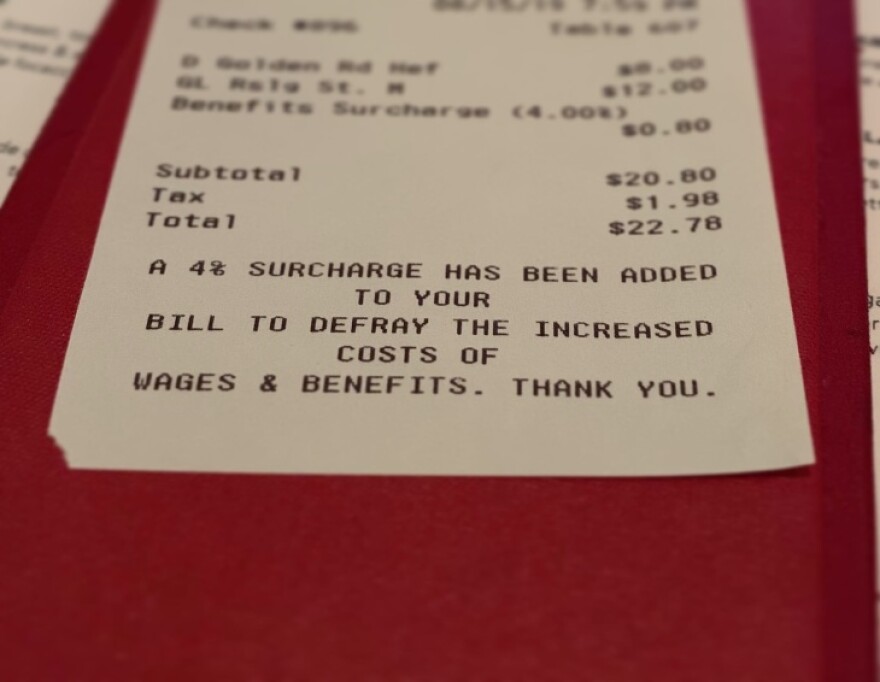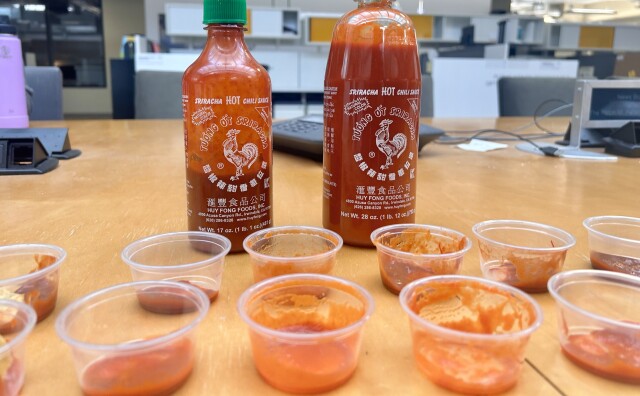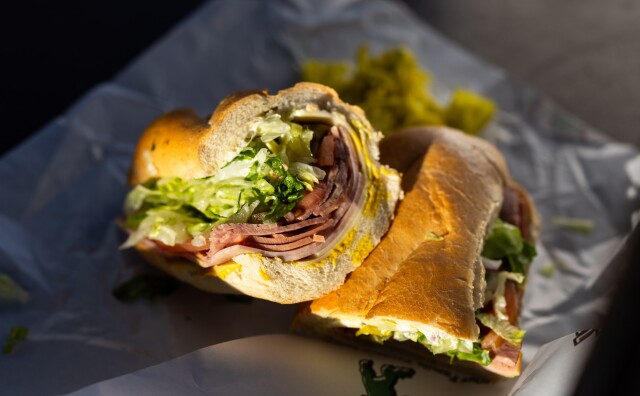If A Restaurant Adds A Surcharge, Do I Still Have To Tip?

Editor's note: This story was first published in Aug. 26, 2019, and remains one of the most popular stories on our website. We updated the story in May 2023 and republished it.
You know the feeling when you're dining out and you order items from the menu that are within your budget, then the bill arrives and you spot a "surcharge" or "fee" that tacks on 10% in addition to the 15 to 20% you were planning to leave as a tip because you aren't a total jerkface, so you decide to rage-shame the restaurant by posting a picture of your receipt online?
You might not, but you probably know someone who has.
Restaurant surcharges aren't new, but they are newly contentious, and unhappy customers have taken to Reddit and social media, posting photos of their receipts and lambasting establishments for the practice.
One consumer even created a Google spreadsheet to track restaurants that add these charges to your bill.
If you think you're seeing these surcharges more often than you used to, you're not wrong. They've been on the rise in Los Angeles, according to Sharokina Shams of the California Restaurant Assn.
Pre-pandemic, restaurants began tacking them on to supplement employees' wages, pay for health care, cover the rising cost of doing business and even fight climate change. From Denver, Colorado to Newport, Rhode Island, the practice caught on.
Post-pandemic, it continues to be a way for some restaurants to cope and keep the doors open. The National Restaurant Association reported that in a recent survey of its members, nearly 91% of restaurants reported raising menu prices to deal with post-pandemic fallout and rising costs and 65% made menu alterations to help with the bottom line. Moreover, 16% of restaurants surveyed said they were adding on fees or surcharges. And of those who reported doing so, 75% said they planned to keep those added charges in place for at least a year.
Translation: Start looking for the fine print on menus, or call ahead and ask in advance if you'd like to discretely know this information before you place your order.
Locally, HiHo Cheeseburger in Santa Monica adds a 6% service fee to your order and notes: "A 6% fee will be added to your bill: This is not a gratuity or tip. We are a no-tipping establishment." In downtown L.A., Guerrilla Tacos adds a 4% charge, according to its online menu, which adds: "A 4% surcharge is added to each check to allow us to provide health insurance for our employees at no cost to them."

Restaurants aren't the only ones charging extra fees. Amoeba Records adds an extra 35 cents to your bill. It started implementing the fee in January 2018 in response to an increased minimum wage and paid sick leave requirements, according to Chris Carmena, general manager at the Hollywood store. In downtown Los Angeles, the swanky, new Alamo Drafthouse adds a 3% service charge so they can pay their "back-of-house employees a competitive livable wage." Business owners say the charges are a way to help businesses with a slim profit margin keep the doors open. The hourly minimum wage in California recently got a bump, to $15.50 for all employers. Combine that with other costs of doing business — rising food prices, single-use plastic ordinances — and it's all driving up costs, said HiHo Cheeseburger cofounder Jerry Greenberg. "We're not complaining about it," Greenberg said. "We're dealing with it."
How did we get here?
In the United States, San Francisco may have been the tip of the spear. These surcharges started popping up there more than a decade ago, Shams said. In 2008, the city's Health Care Security Ordinance went into effect, requiring businesses to provide health care expenditures for employees. Businesses passed that cost on to customers, often in the form of surcharges. Other California cities, including Los Angeles and San Diego, followed suit.
From movie theaters to record stores to restaurants, these charges are the new normal.
It puts 'everyone at odds'
Surcharges are usually small, up to 10% of your total bill, and they're "meant to contend with a specific cost increase," such as labor or healthcare, Shams explained.
Fees can be much higher, sometimes up to 20% of your bill, and they're most common at restaurants that have opted out of tipping. This lets operators disperse service fees more equally among restaurant staff.

Businesses aren't legally obligated to disclose surcharges but doing so can help them avoid consumer claims, law firm Wilson Elser Moskowitz Edelman & Dicker LLP explained in an article on the California Restaurant Assn.'s site. The firm advises restaurants to describe the charge using broad language so they have more flexibility over how to use the money.
HiHo explains its 6% surcharge, implemented in July 2019, in a bold, red font about three-fourths of the way down the menu, doesn't seem to bother customers. If customers have questions, HiHo's staff and management are happy to answer them but other than a Reddit post, "not one person" has complained, Greenberg said.
At Hollywood's Amoeba Records, customers see a sign at the front of the store and at each register informing them of the 35-cent "living wage/benefit charge." They can opt out of the fee, Carmena said, by telling the cashier when making a purchase.
The "vast majority of our customers have been understanding and supportive, while a few have chosen to ask for the removal of the fee, which we accommodate," he added.
But having a message on a sign or menu doesn't always mean a guest will see it, and that can lead to uncomfortable situations.
It becomes a "weird social pressure," said Dustin Stredwick, founder and principal of Off Menu Hospitality, a company that advises restaurants on how to run their businesses. A huge factor in customer satisfaction is the interaction they have with staff, he said.
"(A surcharge) kind of puts everyone at odds, and that's not the way a great experience is supposed to end," Stredwick said. It "kind of puts a sour taste in guests' mouths."
The potential awkwardness of customers discovering an extra fee at the end of their meal drove Greenberg's decision to do away with tips and impose a surcharge.
At other fast-casual restaurants, "You go to pay [for your food] and the screen gets spun around to you and it asks: Do you want to tip 15, 18 or 20%? And you kind of scratch your head. That moment of not really being sure what to do, we just kind of side-step that issue," he said.
Cristina DiCarlo is in favor of surcharges. She used to work at a restaurant where she was required to give back 4% of the tips she earned during a shift. "I was turning my money blindly into management, I didn't have any control of where it goes," DiCarlo said.
She thinks a surcharge is a more honest way for restaurant management to fulfill their financial needs. After she responded to LAist's Twitter callout asking Angelenos for their opinions on surcharges and fees, we reached out to her and she told us in a message, "I have never worked at a restaurant with a fee/surcharge but I am familiar with these fees. I sometimes wish that we were protected like that."
Brian Orozco, a former server at Guerrilla Tacos in the Arts District, told LAist that most of the servers at Guerrilla have received questions from patrons about the 3% service fee implemented there.
"People are really happy," Orozco said, once they learn their money goes toward employee benefits..
A not so simple alternative
Exasperated customers who hate these surcharges often complain that an establishment could just raise its prices. Some businesses, however, think that would scare off customers.
"We don't want to be at a competitive disadvantage," Greenberg said.
Amoeba Records echoes that. "We've elected to implement an optional fee of 35 cents per transaction in order to afford the rising costs associated with these benefits instead of raising our prices across the board, which would be a much greater cost to our customers," Carmena said.
"For the consumer, it's still a cost increase whether it's a menu price increase or it's a surcharge," Shams of the CRA said. "Restaurants are struggling with that question: Is there a way to do it without offending the customer?"
The simple answer is no. Whether businesses increase prices or add surcharges, they're going to get complaints about it.
But how do people really feel? It's complicated.
I am totally supportive of this. It is usually stated on the menu. If you have a problem with this, I suggest you go elsewhere.
— Robert Houston (@hrjhouston) August 16, 2019
Consumers in support of price increases generally want to know what they're paying for before deciding where to eat.
"You're taking the control out of the guests' hands," Stredwick said. "When you roll it into the prices on the menu, then you give consumers the power to make a choice."
While many customers like the idea of providing livable wages and health care for employees, they often don't agree with the ethics of surcharges.
Yep. Not a fan. “Defraying increased costs of wages and benefits,” is just “raising your prices to keep up with the market” by another name
— Stewart Campbell (@s_w_campbell) August 16, 2019
Surcharges are a way to raise your prices without changing the prices on your menu, always feels like a dishonest approach to business.
Fine if it’s clearly stated on the menu, so u know beforehand. However, these costs are normal costs of sound business and should be baked into the prices.
— Mark Schaberg (@TrueFreedom626) August 16, 2019
Many people say they'd rather see prices increase but business owners like Greenberg say it's not that simple. They're fighting to stay competitive in a saturated restaurant market and humans are hard-wired to value short-term rewards over long-term costs (i.e. opting for a cheaper burger rather than paying a higher price to ensure a restaurant's longevity).
Go a step beyond the surcharge/fee vs. price increase debate and you'll realize a common theme — customers want a good meal and restaurants just want to give it to them.
"We want to deliver the best food to our guests," Greenberg said. "Day in and day out, that's what we want to do."
What you need to know
So, in this brave new world, how much should you tip?
If a gratuity has already been added to your bill, you don't need to add an additional tip. If you see a service fee that's a replacement for a tip, you don't need to add an additional tip. If a small surcharge appears on your bill, that's a different story. That is not a tip.
"Don't take it out on your servers," urge Reddit users who say they've worked in the service industry. Tip as you normally would: 15% to 20% at sit-down restaurants.
DiCarlo, the former bartender, offered a slight alternative. The first time she encountered a surcharge in L.A., her server suggested she tip the remainder of what she planned to give, she said.
So if you see a 5% surcharge and initially planned on leaving a 20% tip, leave 15% of the pre-tax amount for your server.
Whether restaurants choose to forgo tips and add a surcharge or raise the price of their food, an establishment's success is about more than money, according to Stredwick.
"The restaurants that really create an experience and really make you feel special when you go out," he says, "those are the ones that are going to be the most successful."
-
After people began complaining online that Sriracha they'd bought recently didn't taste like the old stuff, we set out to find the answer. It didn't go well.
-
From tortas to tuna melts, all sandwiches tell a unique story as they celebrate Los Angeles' diverse tapestry of flavors with each bite.
-
The company behind Sriracha told us production has resumed.
-
Dustin Bartz has figured out a way to sell a $6 smashburger — and still make a tidy profit. He enjoys trolling competitors who charge more.
-
Two amateur bakers take on a beloved, almost sacrosanct school treasure.
-
For Jeff Alulis, the Burger Quest became “something bigger” than him.








